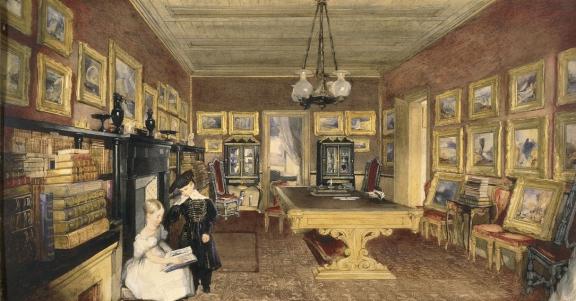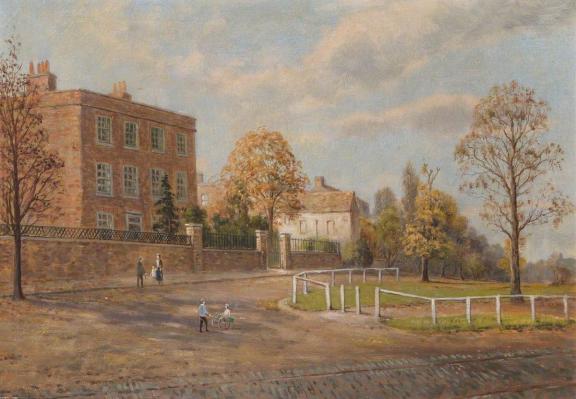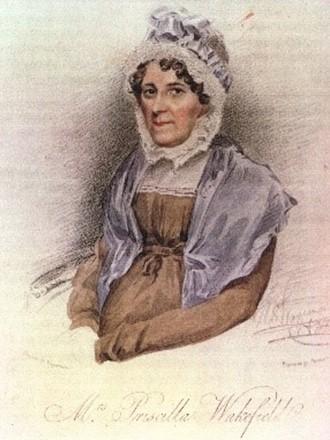Urban Art Trailblazer: Banksy
This is a tale of now you see it, now you don’t ….
In 2009 world-renowned trailblazer and iconic urban artist Banksy chose the side wall of a Tottenham High Road shop fronting Tottenham Green for his next mural. In true Banksy style the artwork ‘No Ball Games’ appeared mysteriously overnight to much intrigue and debate – was it a Banksy or not? You can read more about the meaning and interpretation of this artwork.
The mural held the world’s attention at this spot for the next four years until it was removed unceremoniously and sold in 2013. You can find out more about the time when this landmark Tottenham Banksy left Tottenham Green forever.

(‘No Ball Games’ by Banksy. Photographed taken by and courtesy Alan Stanton)
Trendsetter in Art Collecting: Benjamin Godfrey (BG) Windus (1790-1867)
Tottenham Green in the 21st century may have once had a Banksy, perhaps the envy of modern-day art collectors, but Banksy was not the first artist trailblazer on show here….
Almost 200 years ago, Tottenham Green resident BG Windus was an early collector of some of Britain’s pre-eminent artists. His home, which existed on the land now occupied by Marcus Garvey Library, became the gallery for his collection.
The artworks he owned included one of the finest assemblages of pieces by the artist JMW Turner. As a collector, Windus was a trailblazing trendsetter of the emerging art scene, whilst the artist Turner was certainly a game changer in the art world. His evolving style perplexed critics and contemporaries, turning the tradition of the Old Masters on its head.
John Scarlett Davis' s delightful 1835 painting of BG Windus' Tottenham Library at Tottenham Green provides a fascinating glimpse into what this significant collection once looked like. Windus’ home drew visitors to Tottenham Green, excited to see the work of Turner and also some Pre-Raphaelite artists, the new kids on the block.
You can find out more and discover the intriguing research about Turner in Tottenham by following the link to this amazing resource by Margaret Burr:
Turner in Tottenham - Benjamin Godfrey Windus: the Turner collector

(The Library at Tottenham, the seat of B. G. Windus, Esq John Scarlett Davis, 1835. From the collections and © British Museum)
A Class Act! Education Reformer William E. Forster (1818-1886)
William Forster came from a long line of educators and advocates from Tottenham interested in advancing education for all people. The Forsters were an eminent Quaker family involved in different social campaigns. For William, he was responsible for introducing the Elementary Education Act of 1870. This was a radical step towards formal education being made freely available to everyone for the first time. In the decades that followed a massive school building programme followed
The Forster family had long ties with Tottenham and educational reform. In 1752 Josiah Forster (1693-1763) opened a Quaker school on the eastern side of Tottenham Green. The school continued after his death and was relocated across to the other side of the Green at Eagle House, the site where Tottenham Town Hall was later built. Grove House School, where William himself went to school, is the College of Haringey, Enfield and North East London today. Forster Road, located a little further up off Tottenham High Road, remembers the family and their dedication to education and the Tottenham community.

(Eagle House, Tottenham Green by John Bonny (1874-1948). From the collections and © Bruce Castle Museum and Archive)
The Original Weatherman – Luke Howard (1772-1864)
Fellow Quaker and reformist Luke Howard spent many years living near Tottenham Green at a large house on Philip Lane (where Arnold Road meets Philip Lane today). It was in his garden at this address that Howard took daily readings on the weather which would contribute to his groundbreaking publication, ‘The Climate of London’, 1818. His work transformed how the world understood weather and climate, earning Luke Howard the title ‘Father of Meteorology’. Luke Howard is remembered by Tottenham’s only English Heritage Blue Plaque at the house he spent his final years in, 7 Bruce Grove. Read more about Luke Howard.

(Extract from Luke Howard’s later edition of ‘The Climate of London’. From the collections and © Bruce Castle Museum and Archive)
The Forgotten Feminist, Economist and Children’s Author: Priscilla Wakefield (1751-1832)
The Quaker, philanthropist, writer and feminist economist Priscilla Wakefield lived at Ship’s Yard, near the site now occupied by High Cross United Reformed Church. She spent her life actively engaged in social action and the alleviation of poverty in Tottenham. She founded both the Lying-in Charity for Women and the School of Industry for girls. A proto-feminist economist, Priscilla also founded a Frugality Savings Bank in Tottenham; widely acknowledged as the first Savings Bank in England. Along with many in Tottenham’s Quaker communities, Priscilla Wakefield was an abolitionist.
She was well-read with an enthusiasm for education and learning as well as the economic emancipation of women, political issues of the day and the topics of science, history and geography. Her books, written in later life as a result of financial difficulties in her family, reflected her wide range of interests.
Further resources
Priscilla Wakefield: Tottenham activist - Priscilla Wakefield: forgotten heroine

Standing up to racism: Rev’d Dr Clifford Hill and the High Cross Church
Rev’d Dr Clifford Hill was the senior minister of the High Cross Congregational Church (now the United Reformed Church) on the High Road, opposite Tottenham Green, in the 1960s. His church was said to have the largest multicultural congregation in Britain. He used to host a regular weekly broadcast on the BBC Caribbean Service, reporting on life among the migrant communities in London. He also wrote a number of books on Caribbean and African immigration – the first was 'Black and White in Harmony' in 1958. During the 1960s Rev’d Hill went to Barbados, Trinidad and Jamaica on behalf of the British Council of Churches.
On Commonwealth Sunday in June 1961 the High Cross Congregational Church was due to broadcast the service from Tottenham to the Caribbean, and an extra-large number of attendees arrived. The church was full, with 1,500 people inside and many people not being able to get in, standing on the street outside (as you can see from the photograph).

(The view of the congregation overflowing onto Tottenham High Road and unable to get into the service to attend the Commonwealth Sunday at the High Cross Congregational Church in June 1961. Photograph courtesy Rev’d Clifford Hill).

(View of the Commonwealth Sunday service in June 1961with 1.500 people in attendance inside the High Cross)
Race relations at that time were poor and the church was often picketed by the British National Party (BNP). The Rev’d Hill used to receive many insulting letters. His house at 96 Downhills Park Road in Tottenham was on one occasion attacked during the night. White paint was thrown over the door and racist and offensive words were painted on the wooden fence at the side of the house and on the pavement in front of the house. Tottenham Borough Council sent workmen to try to scrub out the words. Unable to remove them, they simply turned over the paving stones.
The incident rebounded on the BNP, because there was a considerable outcry from the population in Tottenham, supporting the church and rejecting the racism of the BNP.
Further resources
Read more about the work of Rev’d Clifford Hill and his time at the High Cross Congregational Church
Motoring to the Future: Mr Zwicky and his Fire Engine
Back in 1906, when local authorities provided firefighting services, the enterprising Tottenham Urban District Council transformed how fire brigades were able to attend fires in this country.
With Swiss-born Mr Jean Zwicky, a mechanical engineer, in their employ, he designed and built a proto-type motorised fire engine, contributing to the development of firefighting equipment and fire engines.
Read more about how the original horse-drawn fire pumps had certainly had their day.
Location
Tottenham Green Trailblazers
1 Philip Ln
Tottenham
N15 4JA
United Kingdom